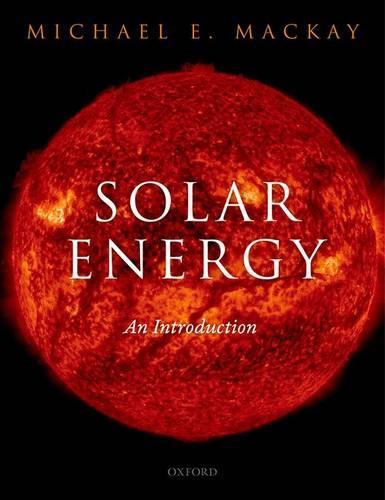Overview
The information in this book can be used to teach advanced undergraduate or beginning graduate students the fundamental science and engineering of solar energy technologies. It is written in a way that will allow the reader to generalize the information presented in the book rather than present a compendium of facts. A concise and detailed review of solar energy and its interaction with materials is first given followed by discussion of photovoltaic devices and solar thermal technologies like the solar chimney, solar (power) tower, flat plate water heater, and electricity generation. This is a broad and detailed presentation of information that can be used by the reader to understand existing solar energy related technologies or to design their own.
Full Product Details
Author: Michael E. Mackay (Professor of Materials Science & Engineering and Chemical & Biomolecular Engineering, University of Delaware)
Publisher: Oxford University Press
Imprint: Oxford University Press
Dimensions:
Width: 19.50cm
, Height: 1.80cm
, Length: 24.70cm
Weight: 0.694kg
ISBN: 9780199652105
ISBN 10: 0199652104
Pages: 256
Publication Date: 02 July 2015
Audience:
College/higher education
,
Professional and scholarly
,
Tertiary & Higher Education
,
Professional & Vocational
Format: Hardback
Publisher's Status: Active
Availability: To order

Stock availability from the supplier is unknown. We will order it for you and ship this item to you once it is received by us.
Reviews
Solar radiation is likely to be a key part of our energy future. This textbook presents, with admirable clarity and accessibility, the relevant physics, the technical approach and challenges, and the geopolitical arguments, behind the utilisation of solar power on a global scale. Fred Taylor, University of Oxford, UK Michael Mackay's Solar Energy is a useful contribution to the field by combining photovoltaics and solar thermal energy-two subjects not often seen together in one textbook. The topics are explained at an approachable level, making the book a good entry text for a student or a teacher who may wish to understand solar energy conversion from this broader point of view. Tom Markvart, University of Southampton, UK
... this is a comprehensive guide to the mechanisms behind current solar technology as well as the physical, interpretable, and quantitative descriptions of how these technologies operate. ... Recommended. * R. J. Barthelmie, CHOICE * Michael Mackay's Solar Energy is a useful contribution to the field by combining photovoltaics and solar thermal energy-two subjects not often seen together in one textbook. The topics are explained at an approachable level, making the book a good entry text for a student or a teacher who may wish to understand solar energy conversion from this broader point of view. * Tom Markvart, University of Southampton, UK * Solar radiation is likely to be a key part of our energy future. This textbook presents, with admirable clarity and accessibility, the relevant physics, the technical approach and challenges, and the geopolitical arguments, behind the utilisation of solar power on a global scale. * Fred Taylor, University of Oxford, UK * Solar Energy is an engaging collection of important information and insights that fills a valuable space between the growing collection of energy-themed textbooks and the more specialized treatises on renewable energy, solar engineering, and PV devices.[...] It is a timely contribution in a world where carbon emissions are PV installations continue to increase and where the renewable-energy community continues to face the challenge of coupling energy production and storage to fully utilize the power of solar energy. * Nancy M. Haegel, Physics Today * The book is clear and, despite its small size, very dense in information. It stimulates learning by tackling the subject from many points of view. * Rosaria A. Puglisi, MRS Bulletin a * Solar Energy is an engaging collection of important information and insights that fills a valuable space between the growing collection of energy-themed textbooks and the more specialized treatises on renewable energy, solar engineering, and PV devices. * Nancy M. Haegel, Physics Today. *
Author Information
Michael E. Mackay received his undergraduate degree in chemical engineering with distinction from the University of Delaware, then worked for Proctor and Gamble prior to attending graduate school at the University of Illinois (Urbana) where he received M.S. and PhD degrees in chemical engineering. He subsequently became a postdoctoral fellow at the University of Melbourne (Australia), and has had positions at the University of Queensland (Australia), Stevens Institute of Technology, Michigan State University, and is presently the distinguished Professor of Materials Science and Engineering at the University of Delaware. He is a nationally and internationally known leader in nanotechnology specializing in how nanoparticles improve polymer performance and their use in making novel devices and materials. Recently, he has focused his research efforts to make polymer-based solar cells that that can be made on any surface.



